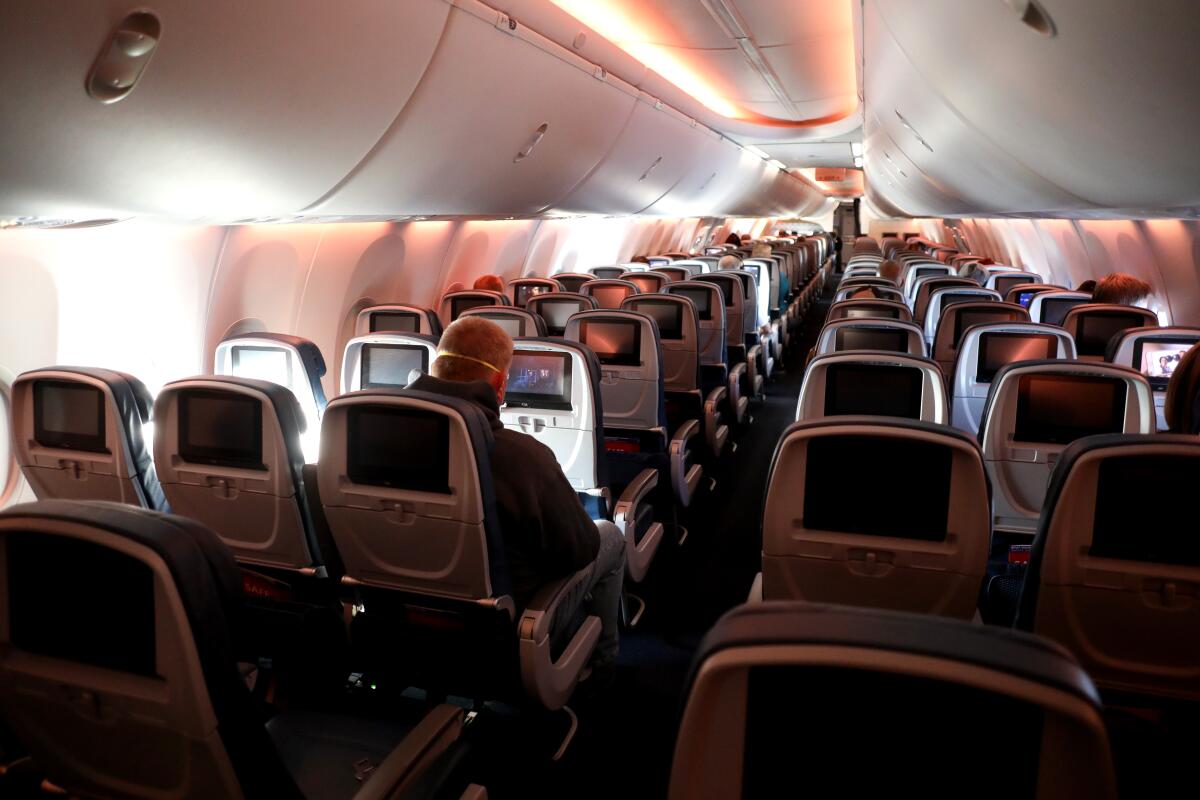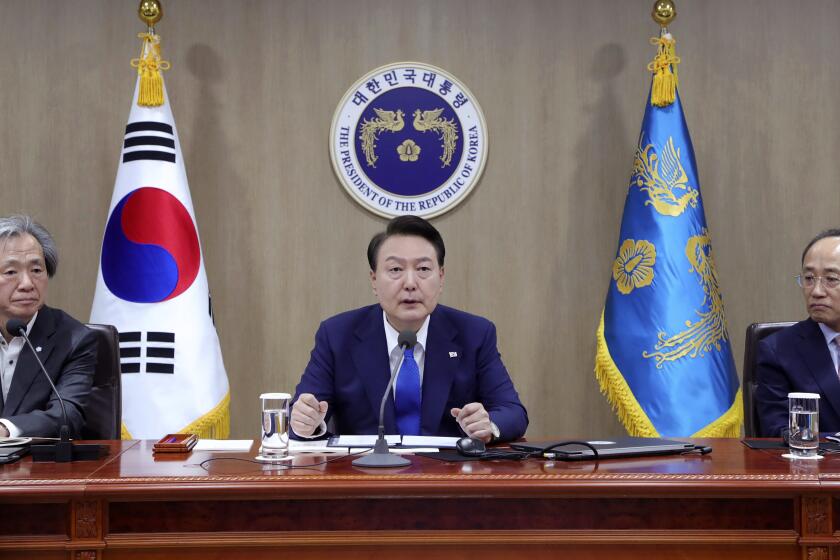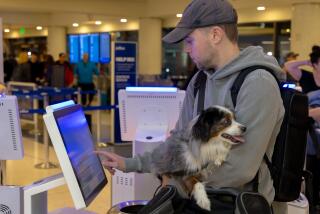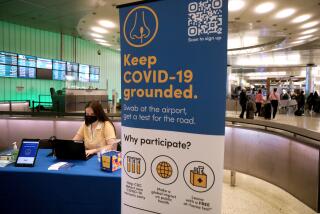Is flying safe amid coronavirus outbreak? Here’s what medical experts say

- Share via
To help revive the devastated travel industry, airline trade groups and aviation manufacturers are kicking off campaigns to convince travelers that the risk of being infected by the coronavirus on a flight is low thanks to improved cleaning efforts and sophisticated cabin ventilation systems.
Medical experts tend to agree, with one caveat: The risk goes up as more passengers are crammed into a plane.
Still, a group that represents several of the nation’s low-cost airlines is seeking federal regulators’ permission to pack passengers into cabins without having to space them out to reduce the risk of spreading the virus.
The National Air Carrier Assn., a trade group for 18 low-cost passenger and cargo carriers, wrote last month to U.S. Transportation Secretary Elaine Chao, arguing against any capacity limits, including a requirement that airlines leave the middle seat vacant.
The group wrote that imposing “arbitrary” capacity limits on carriers could lead to higher fares or even airline bankruptcies.
The trade group, whose airlines have some of the most cramped seats in the industry, wrote the letter in response to requests from the top Democrats on the congressional transportation committees, Sen. Maria Cantwell (D-Washington) and Rep. Peter DeFazio (D-Oregon), that Chao require airlines to space passengers out to reduce the risk of infection.
Chao has not responded to the request.
Consumer groups have also chimed in on the debate.
The head of an airline passenger rights group says that Chao and the U.S. Department of Transportation should impose rules to force airlines to space passengers out.
“If they don’t do something, they are going to make us one big hot spot,” said Paul Hudson, a member of an FAA rule-making advisory committee and president of Flyersrights.org, a consumer group with more than 60,000 members.
Hudson called the trade group’s request to allow airlines to pack in passengers without adhering to the CDC recommendation of social distancing “ridiculous.” He also wants federal regulators to require that passengers wear masks.
The nation’s largest union of flight attendants has weighed in, asking lawmakers to require masks on all passengers and, for now, prohibit leisure and nonessential air travel to reduce the risk of infecting flight crews.
The pandemic has revived a decades-old debate about the risk of being infected by a fellow passenger on commercial planes.
Healthcare experts agree with the airline industry that the risk of being infected by another passenger is low.
“It’s not risk-free to travel on a commercial aircraft but the risk is relatively low,” said Dr. Dean Winslow, an infectious disease specialist at the Stanford University Medical Center and a former flight surgeon with the U.S. Air Force.
Winslow and other healthcare experts say the air in a plane is frequently recirculated, mixed with clean outside air and filtered, making it difficult for germs and viruses to travel throughout a cabin. But the airflow system doesn’t help much, they note, if you are seated shoulder to shoulder with a sick passenger on a long-haul flight.
“Flying on planes is relatively safe from transmission of infectious particulate if you are not near anyone else,” said Dr. Timothy Brewer, a professor of medicine, division of infectious diseases at UCLA’s David Geffen School of Medicine. “If they are going to pack the plane … then there is a higher risk.”
To boost travel demand, Airlines for America, a trade group that represents the nation’s ten largest carriers, recently launched a “Fly Healthy. Fly Smart” campaign to promote the industry’s efforts to reduce the risk of infection on a plane. The campaign also emphasizes that cabin air is filtered through high efficiency particulate air (HEPA) filters to generate hospital-grade air for passengers.
The International Air Transport Assn., a trade group that represents 290 airlines in 120 countries, jumped into the fray recently with a report titled “Restarting Aviation Following COVID-19.” The report cites several studies that suggest that the number of passengers infected by the coronavirus on a plane has been minimal.
Meanwhile, Boeing announced last week the appointment of longtime executive Mike Delaney to lead a new Confident Travel Initiative to develop “solutions to help minimize air travel health risks amid the COVID-19 pandemic and drive awareness of health safeguards already in place.”
The initiative will study the use of new disinfectants, antimicrobial surfaces and ultraviolet light in plane cabins to reduce the risk of infection. In addition, Boeing is creating graphics, videos and website pages to help airlines promote the technology currently used on the planes, said Jim Haas, director of product marketing.
“We are trying to get the message out everywhere,” he said.
Delta’s chief executive, Ed Bastain, said he plans to test all employees for COVID-19 as the carrier prepares for an increase in demand this summer.
The reason is obvious. Passenger traffic at U.S. airports began to drop dramatically, starting in mid-March, to a low of fewer than 88,000 passengers on April 14, based on the number of passengers screened by the Transportation Security Administration. On that same date last year, the TSA screened 2.2 million fliers.
Since then, the daily total of passengers screened at U.S. airports has climbed to a high of nearly 353,000 on May 31.
Ari Rastegar, a real estate investment executive from Austin, is among those who are ready to fly again. He stopped flying for business when the COVID-19 pandemic first hit the U.S. but he is now back to taking three or four airline trips a month. He wears a mask and wipes down surfaces with disinfectant.
“Everything is a risk,” said the chief executive of Rastegar Property Co. in Austin. “You could get the flu. You could get hit by a car. We can’t live in a state of constant fear. We have to go on with our lives and be resilient.”
Rastegar, 38, believes that the risk of being infected on a plane is relatively low as long as he wears a mask, washes his hands and wipes down surfaces. He also credits the airlines for more frequently cleaning the cabins and requiring passengers to wear masks.
“I’m taking those precautions and wearing my mask, at the same time I’m not keeping myself in lockdown,” he said.
Many of the nation’s airlines responded to the outbreak by adopting increased cleaning protocols and requiring passengers and flight crew members to wear face coverings. Delta Air Lines announced this week that it will keep the middle seats on planes empty through Sept. 30 to help create more distance between passengers. Other carriers, such as JetBlue, have also promised to keep the middle seat open.
Several carriers have either eliminated or reduced their traditional food and drink service to cut down on the interaction with the flight crew.
But determining with certainty the source of an infection is not easy. The Centers for Disease Control and Prevention warns that any kind of travel can increase the risk of being infected because of the close contact with other people, whether in a cab on the way to the airport or in a security screening line.
The CDC adds that “most viruses and other germs do not spread easily in the cabin of planes because of how air circulates and is filtered on airplanes.”
Inside the cabin, filtered air mixed with outside air blows down on passengers from vents above the seats and escapes through vents under the seats. The system reduces the likelihood that germs and viruses can travel the length of the cabin, according to aviation industry experts.
“The design flow of planes to recirculate air is actually very thoughtfully done,” Brewer said.
In its report, the International Air Transport Assn., the global airline trade group, cited an informal survey of 18 airlines, representing 14% of the global air traffic, that found no cases of passenger-to-passenger transmission of the virus from January through March.
The report also listed a study of 1,100 passengers who were infected with the virus and had recently flown. The report concluded that of the 125,000 passengers who flew with the infected passengers, only one additional passenger and two crew members were suspected of being infected due to in-flight transmission.
But the report also cited an investigation into a flight from the U.K. to Vietnam on March 2 that suggested that one passenger transmitted the virus to 14 other fliers and a crew member. Twelve of the infected passengers were seated near the infected passenger.
The nation’s airlines got a boost in their efforts when a Harvard public health expert published an opinion piece in the May 18 Washington Post, arguing that the risk of infections from flying in a commercial plane is low because the HEPA filters capture 99.9% of airborne particulates and the air is recirculated every five to six minutes.
“You are more at risk of getting sick when traveling, but it’s not the airplane that’s making you sick,” according to the piece by Joseph Allen, an assistant professor of exposure assessment science at the Harvard T.H. Chan School of Public Health. “Every time you fly, you may also take a cab, bus or subway, stand in long lines at the airport, eat unhealthy foods, sit for extended durations. ... All of these factors are known to affect your immune system.”
The Airlines for America “Fly Healthy. Fly Smart” campaign cited Allen’s article in its campaign literature, as did the National Air Carrier Assn. in its letter to Chao.
“The concept of social distancing is nearly impossible to accomplish in enclosed spaces such as aircraft cabins,” the National Air Carrier Assn. said in its letter opposing limits on cabin capacity. “Aircraft cabins, however, are safe environments.”
More to Read
Inside the business of entertainment
The Wide Shot brings you news, analysis and insights on everything from streaming wars to production — and what it all means for the future.
You may occasionally receive promotional content from the Los Angeles Times.












